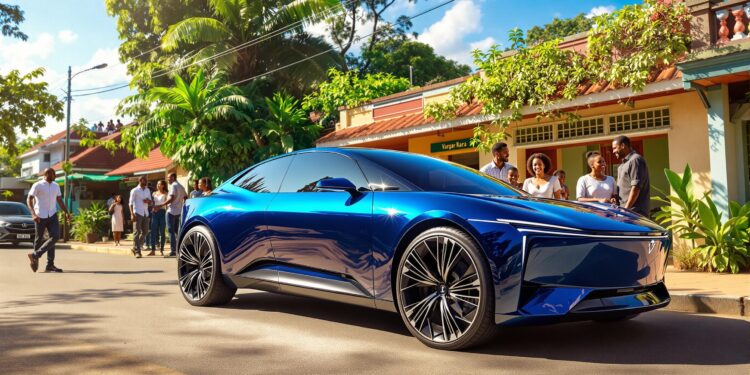Uganda is rapidly embracing electric vehicles (EVs) as a cleaner, cost-effective alternative to traditional fuel-powered transport. Here’s a quick look at five standout EVs shaping Uganda’s mobility landscape:
- Nissan Leaf: A reliable personal car with a 140-mile range, fast charging (80% in 45 minutes), and low maintenance costs.
- E-Bus Xpress: Locally built electric buses for public transport, featuring zero emissions, cashless payments, and real-time tracking.
- Spiro Electric Motorcycles: Affordable bikes with an 80 km range, battery-swapping in 2-3 minutes, and lower operating costs.
- Zembo Electric Motorcycles: Designed for commercial riders, offering leasing options, battery-swapping stations, and lower daily expenses.
- GOGO Electric Motorcycles: Perfect for urban commuters, with a 120 km range, a vast battery-swapping network, and 30% lower costs compared to fuel-powered alternatives.
Quick Comparison
| Feature | Nissan Leaf | E-Bus Xpress | Spiro | Zembo | GOGO Electric |
|---|---|---|---|---|---|
| Range | 140 miles | 300 km | 80 km | 100 km | 120 km |
| Charging/Swap Time | 45 mins (80%) | 4 hours | 2-3 mins | 2-3 mins | 2-3 mins |
| Cost | UGX 108M | Commercial fleet | $1,000 | Lease options | Daily swap: UGX 5K |
| Primary Use | Personal | Public transport | Personal/Work | Commercial Taxi | Urban commuting |
| Special Features | Fast-charging | Cashless, A/C | Battery swapping | Leasing program | Largest swap network |
Uganda’s EV market is thriving due to growing infrastructure, government incentives, and private sector efforts, making EVs more accessible and practical for personal and public use. Dive into the article for more details on each vehicle and how they’re transforming transportation in Uganda.
Best Electric Motorcycle Brands & Their Prices In Uganda
1. Nissan Leaf: A Compact and Reliable EV
The Nissan Leaf is a smart option for Ugandan roads, offering a 40 kWh lithium-ion battery and a driving range of up to 140 miles per charge. Its higher ground clearance and floor-mounted battery provide added stability on uneven surfaces, making it suitable for both city streets and rural areas. Plus, its fast-charging capability allows the battery to reach 80% in just 45 minutes, making it convenient for daily use.
| Feature | Specification | Advantage |
|---|---|---|
| Battery Capacity | 40 kWh lithium-ion | Extended driving range |
| Performance | 140-mile range | Perfect for daily trips |
| Design | Floor-mounted battery | Improved stability |
| Fast Charging | 80% in 45 minutes | Reduced downtime |
For Ugandan drivers, the Leaf offers excellent cost savings. Priced at UGX 108,057,600 for the SV model, it supports Uganda’s efforts to cut fuel expenses and encourage greener transport. With low maintenance needs and reduced operating costs, it delivers long-term financial benefits.
Nissan Uganda has also partnered with local service centers to ensure reliable maintenance support for Leaf owners. This network helps address common concerns about electric vehicle adoption and makes the Leaf a practical choice for Uganda’s roads.
While the Nissan Leaf is ideal for personal and business use, Uganda’s public transport sector is also moving toward electric solutions, with models like the E-Bus Xpress leading the way.
2. E-Bus Xpress: Electric Buses for Public Transport
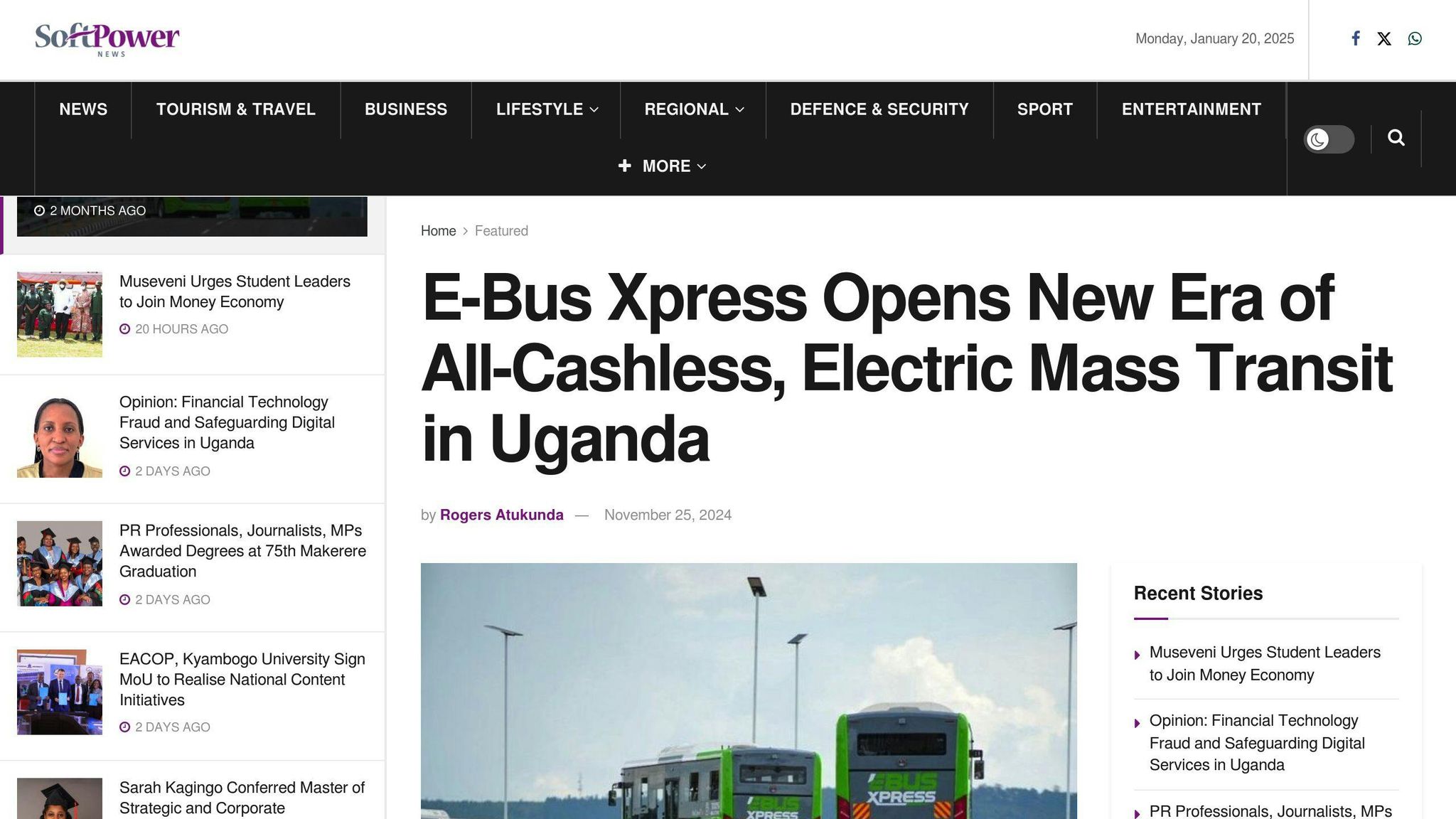
E-Bus Xpress is tackling Uganda’s public transport needs with zero-emission electric buses. Unlike the Nissan Leaf, which focuses on personal use, this service provides a mass transit option along the Jinja-Iganga route, using locally built Kayoola EVS electric buses tailored for the country’s roads and requirements.
These buses bring together eco-friendly features and modern conveniences. They produce no emissions, offer real-time tracking, and include air conditioning for a more comfortable ride. Payments are cashless, handled through KaCyber Technologies, making the process smoother and more efficient. Charging stations along the route ensure the buses stay operational, and their spacious interiors are designed for both short trips and longer intercity journeys.
| Feature | Benefit | Impact |
|---|---|---|
| Zero Emissions | Cleaner operation | Reduces urban air pollution |
| Real-Time Tracking | Accurate arrival updates | Simplifies trip planning |
| Air Conditioning | Comfortable travel conditions | Improves passenger experience |
| Cashless Payments | Digital fare system via KaCyber | Faster, hassle-free transactions |
E-Bus Xpress delivers quiet, smooth rides while supporting Uganda’s environmental goals. The Jinja-Iganga route acts as a pilot, showing how electric buses can transform public transit in the country.
This initiative aligns with Uganda’s commitment to greener transportation. By incorporating smart city technologies and offering real-time travel updates, E-Bus Xpress is setting a new standard for public transport in the region.
3. Spiro Electric Motorcycles: Affordable and Efficient
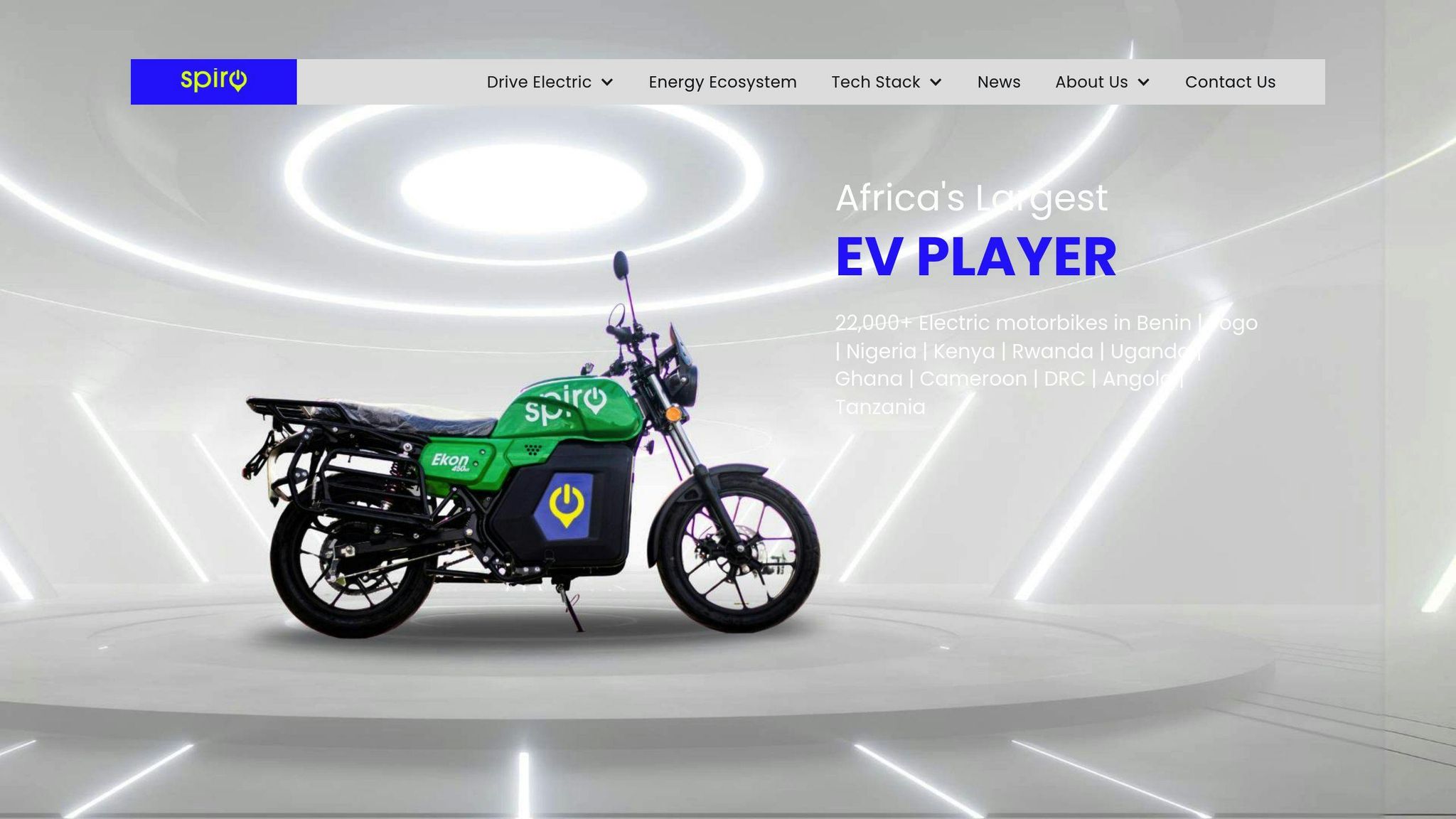
Spiro Electric Motorcycles are making waves in Uganda’s electric vehicle market by offering a practical and budget-friendly option tailored for local roads.
These motorcycles come with impressive features. Each bike has a battery range of 80 kilometers and tubeless tires for better durability. The standout model, the Spiro Commando, is equipped with a 6.5 kW motor that delivers speeds of up to 80 km/h – ideal for both city rides and longer trips.
| Feature | Specification | Benefit |
|---|---|---|
| Battery Range | 80 kilometers | Longer rides without recharging |
| Price | $1,000 | 30% cheaper than fuel-powered alternatives |
| Motor Power | 6.5 kW motor | Smooth and reliable performance |
| Maximum Speed | 80 km/h | Suitable for city and highway travel |
| Weight Capacity | 200 kg | Handles both rider and cargo |
Spiro also stands out with its battery-swapping system. The company has set up swapping stations across Kampala and plans to expand to 35 locations by year-end. Riders can replace drained batteries with fully charged ones in just 2-3 minutes, saving time and eliminating concerns about running out of charge.
"We intend to ensure that we have 100% electric bikes on the market, so your particular model of bike should be cost-effective."
The economic advantages are hard to ignore. Operating costs are much lower compared to traditional fuel-powered motorcycles. Plus, with Uganda generating 90% of its electricity from hydropower, these bikes run on clean energy, reducing environmental harm.
"We are introducing fast battery stations to expand the swapping network."
This initiative aligns with Uganda’s push for renewable energy in transportation. Spiro’s success is a strong indicator of the growing role electric motorcycles are playing in shaping the country’s transport sector, alongside Zembo’s innovative taxi services.
sbb-itb-7bab64a
4. Zembo Electric Motorcycle Taxis: A New Option for Riders
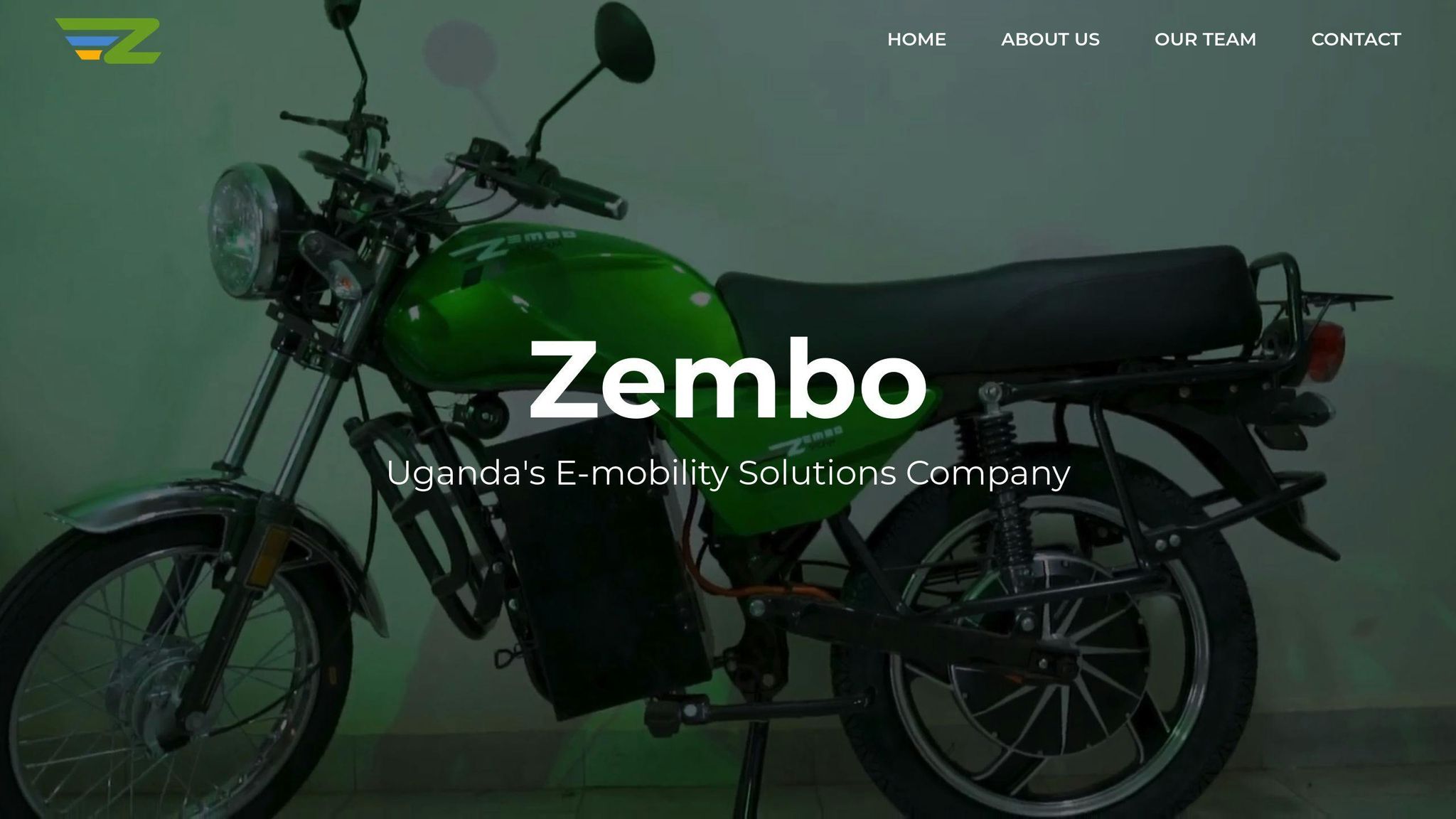
Zembo brings a fresh solution to Uganda’s transportation scene, targeting commercial riders and urban commuters. With over 400 motorcycles in operation across the country, Zembo bikes are built tough, featuring advanced battery tech that ensures reliability and low maintenance – perfect for Uganda’s challenging roads.
These motorcycles are supported by a well-planned charging network. Strategically located battery-swapping stations make it easy for riders to keep going without long delays. This system complements other charging options, strengthening Uganda’s growing electric vehicle (EV) infrastructure.
| Feature | Benefit | Impact |
|---|---|---|
| Battery Swapping Network | Continuous operations | Better productivity |
| Zero Emissions | Cleaner environment | Lower urban pollution |
| Electric Powertrain | Reduced running costs | Higher daily earnings |
| Leasing Scheme | Low upfront investment | Easier access for riders |
Zembo’s financial model is a game-changer for commercial riders. Thanks to an accessible leasing program, riders can start using electric motorcycles with little upfront cost. Plus, eliminating fuel expenses means they can take home more money at the end of each day.
By working alongside companies like Spiro and E-Bus Xpress, Zembo is helping build a cleaner and more profitable transportation system in Uganda. Their approach balances environmental care with practical benefits for riders, making them a key player in Uganda’s shift toward greener transport.
While Zembo focuses on commercial riders, GOGO Electric targets compact urban travel, adding even more variety to Uganda’s EV market.
5. GOGO Electric: Compact and Practical for Urban Use
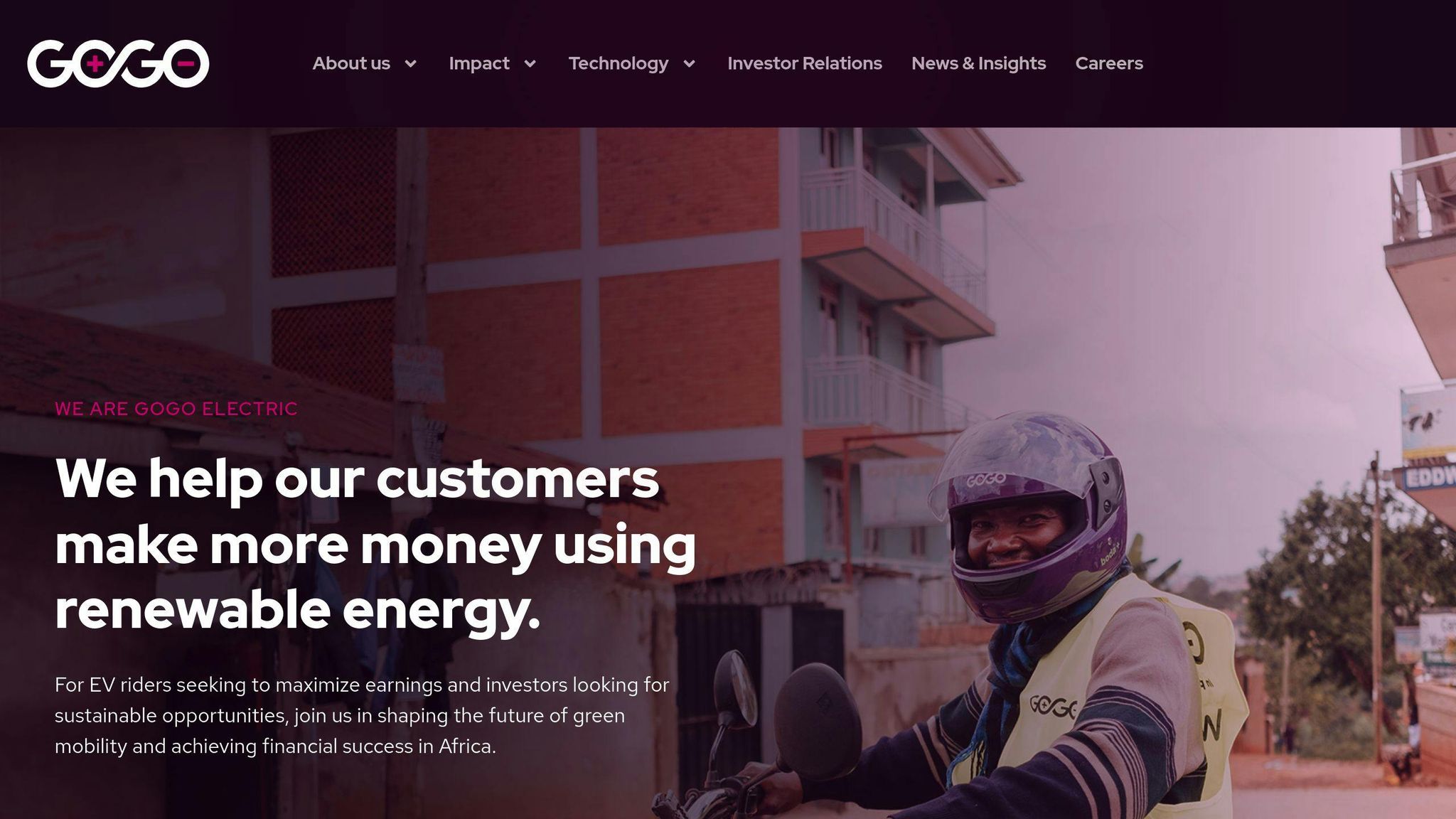
GOGO Electric is designed for urban commuters, focusing on affordable and efficient electric motorcycles (E-BODAs) that suit Uganda’s city life. Since 2019, the company has been reshaping urban transport in Uganda with motorcycles that offer a 120 km range – perfect for navigating Kampala’s bustling streets.
One of GOGO Electric’s standout features is its extensive battery-swapping network, the largest in Uganda. With over 66 stations in key cities like Kampala, Jinja, Iganga, Luwero, and Mukono, riders can swap batteries in under two minutes. This quick process eliminates range concerns and keeps costs low.
| Cost Comparison | Traditional Boda | GOGO Electric |
|---|---|---|
| Daily Fuel/Swap Cost | 15,000 UGX | 5,000 UGX |
| Daily Earnings | 30K-40K UGX | 70K-90K UGX |
| Battery Swaps Needed | N/A | 1 per day |
This model helps riders cut daily costs by 30% while boosting their earnings significantly.
"Our goal was to address the boda boda market’s unique challenges for EV adoption", explains CEO Jakob Hornbach.
GOGO Electric has already sold 1,000 motorcycles and is committed to furthering Uganda’s transition to EVs. The company plans to bring 20,000 drivers into the EV fold, expand its workforce to over 320 employees, and establish East Africa’s largest lithium-ion battery factory by 2024.
These efforts not only reduce emissions but also lower operating costs for riders, supporting Uganda’s vision for cleaner urban transport. GOGO Electric’s urban-focused approach complements the broader EV movement in Uganda, alongside other players like Spiro and Zembo.
Comparison of the Top 5 Electric Vehicles
Here’s a look at the key features and specifications of some of Uganda’s most popular electric vehicles.
| Feature | Nissan Leaf | E-Bus Xpress | Spiro E-Motorcycle | Zembo E-Taxi | GOGO Electric |
|---|---|---|---|---|---|
| Range | 123 MPGe city/99 MPGe highway | 300 km per charge | 120 km | 100 km | 120 km |
| Charging Time* | 40-45 mins (80% charge) | 4 hours | 2-3 mins | 2-3 mins | 2-3 mins |
| Cost (UGX) | 108,057,600 | Commercial fleet | Lease options | Lease options | Daily swap: 5,000 |
| Primary Use | Personal transport | Public transit | Commercial/Personal | Taxi service | Urban commuting |
| Special Features | CHAdeMO DC fast-charging | Air conditioning, Wi-Fi | Affordable financing | Rider support | Extensive swap network |
*Charging times for motorcycles reflect battery-swap durations at designated stations.
The Nissan Leaf stands out for personal use, thanks to its excellent range and quick charging. Its design handles Uganda’s roads well, with balanced weight distribution and ground clearance making it suitable for tougher terrains.
The E-Bus Xpress represents a leap forward in public transportation. These electric buses, part of the Kayoola EVS lineup, combine zero-emission travel with comforts like air conditioning and Wi-Fi, making them ideal for urban transit.
Battery-swapping technology addresses one of the biggest challenges for EVs in Uganda: range anxiety. The three motorcycle options – Spiro E-Motorcycle, Zembo E-Taxi, and GOGO Electric – focus on efficient urban travel. Among them, GOGO Electric stands out for its well-developed battery-swap network, ensuring convenience and accessibility.
All five vehicles come with lower maintenance costs compared to traditional vehicles. Motorcycles, in particular, are the most budget-friendly for commercial riders. Additionally, local service centers and trained technicians, especially for the Nissan Leaf, provide dependable support for long-term use.
Uganda’s EV market is growing fast, offering practical and affordable solutions for both personal and public transport.
Final Thoughts on Electric Vehicles in Uganda
Uganda’s electric vehicle (EV) sector is evolving, thanks to collaborations between the government and private companies like Kiira Motors Corporation (KMC), which is producing electric buses locally. Alongside these efforts, infrastructure to support EVs is steadily growing. For instance, companies like Green Hub are setting up charging networks to ease concerns about driving range for EV owners.
The economic benefits of EVs in Uganda are compelling. Andrew Kananura, an industry expert, highlights this advantage:
"Consider electric cars soon, as the way to go. You are better off having a machine that uses a product (hydroelectric power) that is locally produced and you are never cut off at any point than relying on imported fuel."
Several factors are pushing EV adoption forward in Uganda:
- KMC’s local manufacturing efforts are boosting the domestic economy.
- Charging infrastructure is expanding to meet user needs.
- EVs offer cost savings compared to traditional fuel-powered vehicles.
Uganda’s move toward electric mobility reflects a strong focus on modernizing transportation while addressing practical concerns. Success stories like E-Bus Xpress’s electric transit service show that EV technology works well in Uganda’s transportation system.
Although the upfront cost of EVs remains a challenge, the combination of growing infrastructure and government backing makes the environment increasingly favorable for EV adoption. Uganda’s efforts span both personal and public transport, signaling a well-rounded approach to sustainable mobility.
FAQs
How many electric cars are there in Uganda?
From 2022 to early 2024, Uganda imported a total of 1,694 electric vehicles. This includes 17 cars and 910 motorcycles. Electric motorcycles dominate the market, reflecting their importance in urban areas where they serve as a key mode of transport.
| Key Drivers | Impact |
|---|---|
| Government Support | Initiatives led by Kiira Motors Corporation |
| Infrastructure Growth | Installation of charging stations |
| Private Sector Efforts | Boosting adoption through various programs |
| Cost Advantages | Lower running costs compared to fuel vehicles |
The growth of electric vehicles in Uganda is being fueled by expanding infrastructure, government backing, and private sector involvement from companies like Spiro and Zembo. These efforts, combined with the financial benefits of EVs, are making them an attractive option for Ugandans.
This shift highlights Uganda’s move toward cleaner and more affordable transportation, driven by a mix of public and private initiatives aimed at modernizing the country’s mobility landscape.
Related posts
- SUV vs Sedan: Best Choice for Ugandan Roads
- Top 7 Platforms for Buying Car Parts Online in Uganda
- Uganda’s Localization Policies in Automotive Manufacturing
- Discover Uganda’s Most Economical Cars for Daily Commuting

